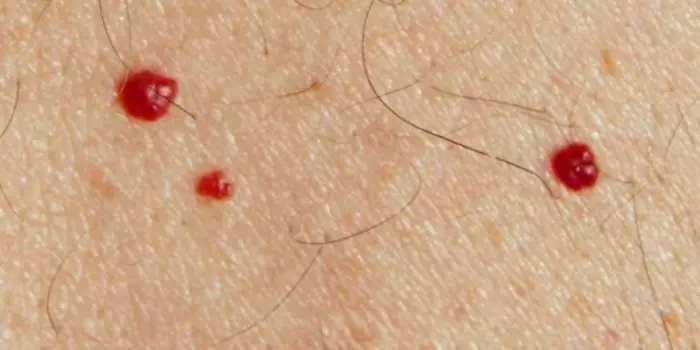Angiomas, known as red moles, in medical practice are usually classified as benign formations that consist of lymphatic or blood vessels. Their appearance is explained by dysfunction of either the circulatory or lymphatic systems. They form throughout the entire period of a person’s life, but only in childhood up to 7 years are angiomas able to disappear on their own.
Red moles on the body - what are they?
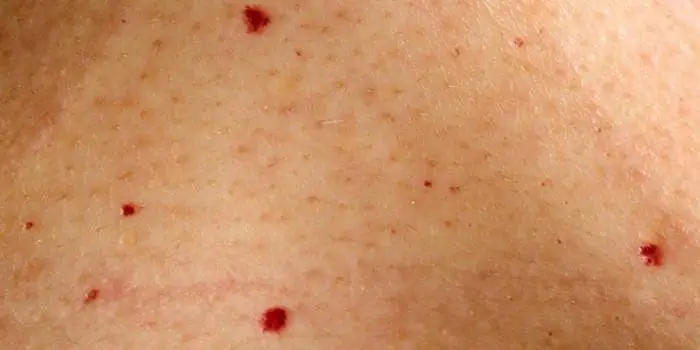
What do red moles on the body mean? According to experts, they are an intermediate link between a malformation and a tumor. The medical literature provides little information about this phenomenon. This is due to the fact that red moles do not pose a particular danger to humans. They are believed to be innate.
Types of red dots (angiomas) with photos
Red moles are usually divided into several varieties. Their classification is based on factors such as the cause of its appearance, location on the body, and the type of vessel that caused its formation. Depending on the cause of angioma and the composition of the tissue, there are red dots or moles of several varieties:
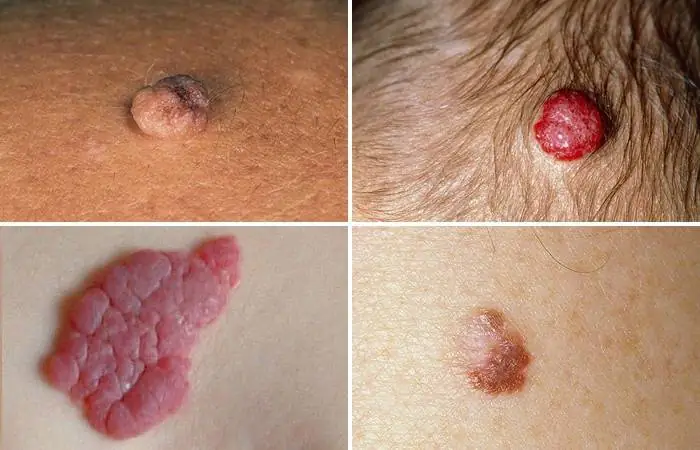
- pineal - a convex neoplasm that rises sharply above the skin;
- nodular - a small pinpoint formation that appears as a result of a blood vessel emerging onto the surface of the skin. This angioma does not have a capillary branch;
- branched or arachnid - a network of small blood vessels extends from the angioma;
- flat - a mole on the skin in the form of a compaction.
Depending on the vessels underlying the formation of red moles, they are called hemangiomas - moles formed due to abnormalities of blood vessels, and lymphangiomas - points that appear due to disruptions in the lymphatic system. Hemangiomas are impressive in size. Lymphangiomas are a rare occurrence. These are small nodules that are soft to the touch and easily compress when pressed. Formed on the neck, mouth, axillary and groin areas. Hemangiomas formed from vessels of the circulatory system are distinguished by external features and size:
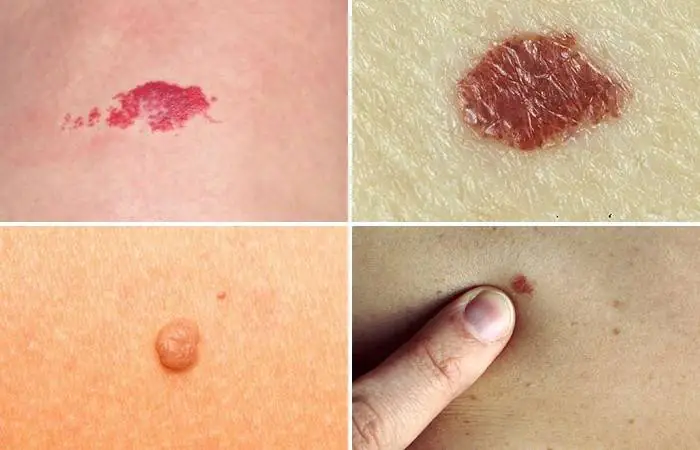
- Capillary - formations that can be located anywhere in the body and look like a blue-purple or bright red spot. They are formed due to the expansion of a capillary vessel.
- Cavernous or cavernous are large formations containing several blood vessels that merge into large cavities. Such hemangiomas are located above the skin. A typical location is the face. Sometimes they can be located on internal organs - the uterus, spleen, liver.
- Branched - they are a pulsating, swollen formation that is filled with blood; they combine several simple moles.
- Punctate are the smallest hemangiomas, which appear as small dots.
Where are they located?
Angiomas are formations of different sizes and shapes. They are localized in tissues and organs: on the skin, in fatty tissue, bone tissue, liver, muscles, brain and kidneys. Such spots appear on the body in childhood and adolescence. Their appearance can also provoke pregnancy. Red dots can be single or multiple. If the former do not pose a danger, then the sudden appearance of multiple angiomas signals serious problems, which may include cancer.
Simple angiomas are located on the skin of the face and scalp. They are characterized by their small size, spherical shape, and purplish-blue color. In some cases, angiomas can occupy large areas on the eyelids, cheeks, nose, and external genitalia. Cavernous angiomas are localized in the subcutaneous area. Sometimes they grow into deep layers - into muscles and bones. This type of formation can develop in internal organs. 80% of angiomas are located in the upper part of the body: on the chest, back, head, face, neck, arms.
The most unfavorable location of angiomas is the head. This is explained by the possibility of damage during haircuts, combing or blow-drying. Red moles on the chest cause particular concern for women. Their single appearance does not pose any danger. However, if angiomas change color, begin to grow, itch or hurt, you should consult a doctor.
Causes of red moles on the skin
According to experts, in most cases such moles are congenital. The sources of their development are pathologies of the vessels of the lymphatic and circulatory systems. Angiomas can appear at any age. Red moles are often observed in children. From the point of view of doctors, this is explained by the transformation processes characteristic of this age.
In girls, angiomas form more often. Small formations go away on their own, without drug intervention. One of the reasons for the appearance of angiomas in newborns is considered to be infectious diseases suffered by the mother during pregnancy. In adults, the formation of angiomas occurs under the influence of hormonal changes and various disruptions in the functioning of the body. Among them:
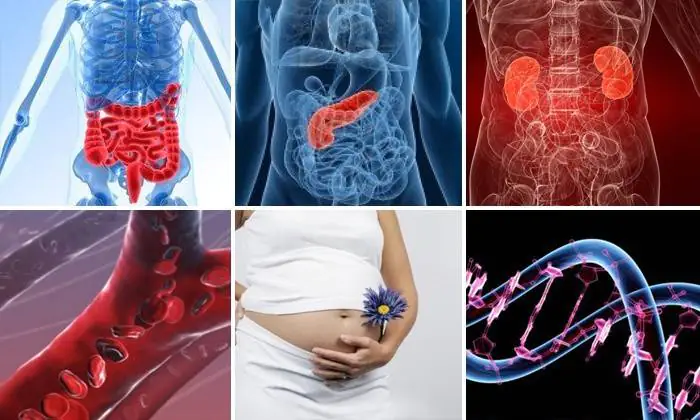
- gastrointestinal diseases,
- pathology of the pancreas,
- exacerbation of chronic infections,
- pyelonephritis,
- deterioration of blood microcirculation,
- dysfunction of pigment cells,
- pregnancy,
- hereditary factor
- hormonal changes,
- lipid metabolism disorders,
- cardiovascular diseases.
Doctors believe that excessive sunbathing and solarium contribute to the appearance of red moles. It is assumed that angiomas can accompany diseases such as Henoch-Schönlein disease, rheumatoid arthritis, and lupus erythematosus. This happens because the immune system, due to emerging pathologies, sees the body’s cells as foreign and tries to suppress them. According to doctors, the appearance of angiomas may signal a blood clotting disorder.
How to remove red dots on the human body
In most cases, these formations do not require medical intervention. However, if the angioma bothers you - it itches, hurts or enlarges, it is recommended to remove it after an appropriate examination. Angiomas are removed if they negatively affect a person’s appearance, are located in places of contact with clothing, interfere with the performance of procedures to care for one’s appearance, or are often subject to accidental damage. Modern medicine offers several options for removing angiomas:
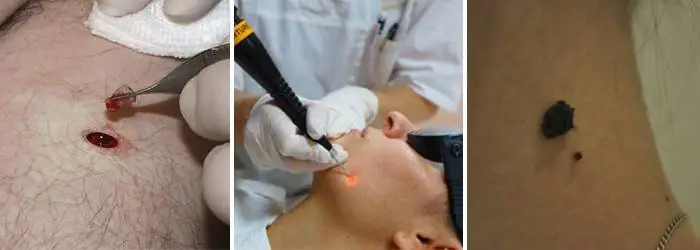
- Surgical excision. This method of removing a red mole is carried out only in a hospital setting. Performed by a surgeon without hospitalization. After excision, scars may remain on the surface of the skin, so the method is used to eliminate small moles located on the body. Surgical excision is not used for formations located on the face.
- Laser removal is the most popular way to get rid of angiomas. It is produced in layers, which ensures work with formations of any depth. Before the manipulation, the location of the angioma is anesthetized with an injection or application of an anesthetic gel. The procedure is short-term and lasts a few seconds. After excision, a crust forms at the site of the angioma within 24 hours, which disappears after 1-3 weeks. After complete healing, minor scars remain at the site of the mole.
- Cauterization is an effective and safe way to get rid of angiomas. Leaves no traces. Cauterization is performed using the coagulation method or using carbon dioxide and nitrogen. The first method can be used to remove large capillary formations. Before the procedure, local anesthesia is performed. Several coagulation methods are used - electrocoagulation, radio wave, infrared and light. Carbon dioxide is used to remove only small formations that are located above the surface of the skin.
Regardless of the chosen method of removing a red mole, it is recommended to make a preliminary diagnosis to exclude oncology. The specialist will be able to choose the best option for removing the angioma. After getting rid of a mole, it is not recommended to visit the sauna, solarium or expose the area where it was previously located to insolation for two months.
Treatment at home using traditional methods
Traditional methods of treating red dots can be used only when the mole is not inflamed, does not bleed, and is small in size. It is prohibited to treat large formations and angiomas that penetrate deep into the skin. According to reviews, the most popular and effective folk methods of getting rid of red moles are:

- Bee Honey. They lubricate the unwanted formation several times a day. After 10 days, the moles will begin to shrink.
- Castor oil. To reduce the size of a mole, apply it to its location overnight.
- Black radish is used to lighten moles. For this purpose, the root vegetable is grated on a fine grater, and the resulting pulp is applied to the problem area. The procedure should be carried out 2-3 times a day.
- Dandelion root. Clean, crushed root is applied to the mole every day for two hours.
- Onion. It is crushed and the juice is squeezed out of the resulting pulp. Lubricate the mole with it. After a month, the formation will dry out and disappear.
Are angiomas dangerous?
In most cases, angiomas are not dangerous. However, in some cases (very rarely), under the influence of unfavorable factors, they degenerate into malignant formations. Among these reasons, experts identify: damage to clothing, exposure to ultraviolet rays. In addition to the danger of degeneration, the cost of damage to the angioma's halo can be heavy bleeding.
Angiomas located in places of contact with clothing - in the abdomen, shoulders, neck, chest - require special attention. Hanging moles, which are easiest to pick off, and angiomas on the head are susceptible to increased trauma. Constant scratching, using a hairdryer, hairpins, headbands, and haircuts can damage the nevus. The danger is caused by angiomas located in the mouth, on the lips and near the organs of vision and hearing. In the oral cavity, moles can be subject to constant mechanical stress, which will contribute to their growth.
What to do if a red mole itches?
If a red mole begins to itch, this is a signal about the beginning of its growth, which may be associated with its degeneration into a malignant tumor. However, in some cases, angioma begins to itch when there is a disruption in the functioning of any body systems or a change in hormonal levels. Itching and flaking of red moles are often observed in pregnant women.
You will not be able to determine the reason for this behavior of a mole on your own, so to clarify the situation, you should consult a dermatologist or an oncology clinic. The hospital will order a series of tests, which include studying hormonal levels and determining the presence of malignant cells. Circular movements over the angioma or light pressure will help you get temporary relief from itching. You can't scratch a mole.
Is it possible to sunbathe and lead an active lifestyle?
The presence of red moles is not a contraindication to an active lifestyle. The only limitation may concern the possible methods of influencing angioma. If it interferes and is located in places of possible contact with surfaces and objects - on the arms, legs, it should be removed to avoid injury. As for sunbathing, as in the absence of red moles, doctors advise not to get carried away with sunbathing.
If there are any types of moles on the body, including red ones, being in the open sun is allowed before 10 a.m. and after 7 p.m. Due to increased activity of ultraviolet rays near bodies of water, you should stay away from water. To protect angiomas from sun rays, dermatologists recommend applying creams with a protection filter of 30 units.
Every day we see our own reflection. Often, due to the rush to work/school in the morning, we sometimes pay little attention to our morning appearance. Be it an unusual pinkness of the cheeks, small teenage pimples, tiny red dots on the body. The first two can be explained unambiguously, the latter have several reasons and prerequisites. Or a new mole begins.
A little oddity
In general, the appearance of unusual points usually causes unjustifiably bad associations. The appearance of precisely pronounced red dots, stars or small areas of the body usually appears as a small external defect. However, knowing the cancer disease, Campbell de Morgan's points are often perceived as a manifestation of its malignant origin. Most often, similar tumors are brown or black. However, the red appearance can also be recognized as the first sign of skin cancer. True, including small reservations.
The spots have multiple etiologies, the worst of which is considered to be suspicion of skin cancer. Due to their easy detection, it is highly recommended to monitor the following features:
- unevenness of sides;
- presence of roughness, uneven edges;
- changing the shade to a darker tone;
- increase in size.
Diagnosis of the disease
In addition to a possible serious illness, there are simple reasons for such an annoying defect. Elderly people perceive it as a “bell” from the body, indicating skin aging. Guided by the most trivial explanation, one cannot immediately discard other potential possibilities for their appearance:
A common common cause is injury to the epidermis. Consequence of hair removal, for example.
Insufficiency or complete absence of vitamins K and C is also a factor in the appearance of red dots. Often the main manifestation is the fragility of the wall of the blood tubes, leading to frequent hemorrhages even with the slightest influence. A strong handshake, the pressure of a bag harness, or simply throwing a ball manifests itself as internal injuries. Showing, like a red alarm, a sign that it is clearly time to visit a doctor. Sometimes it seems like an insignificant problem, apart from the presence of marks, you can’t just observe it.
The next popular factor in the appearance is the development of hemangiomas. The variant is often called “colored moles.” Also being a type of cancer, it rarely becomes malignant. Delivering mainly only aesthetic discomfort, these tumors develop through blood and lymphatic vessels. Appearances include different parts of the body: starting literally with the face, ending with the tips of the heels.
It is important to understand the hepatic etiology. Possible pancreatitis, hepatitis or cirrhosis of the liver. The spots themselves have some differences from their other “relatives”: they usually appear on the upper limbs, the body itself, the appearance resembles small rays of the sun around the spot, called “liver stars”. The phase of acute manifestations of the disease is easily tracked by the owners with the rays - they simply observe an increase in size.
The last important one is rheumatological cause. Most often, lupus, arthritis, joint problems. Autoimmune processes play a primary role, creating false processes of antibody action against one’s own cells. Externally, it manifests itself in the choice of a specific area for the appearance of spots (the area around the eye, for example), in various forms of rash: papules, spots, dots, bruises, blistering formations.
Elimination of discomfort
Treatment of this defect depends etiologically. We need to forget about its symptomatic form. Yes, it will remove the unpleasant appearance of your own body. But it will not in any way affect the underlying disease, which further exposes the body as a whole to suffering.
Observing a regular picture of formation, perhaps in a special form, in too visible places, you cannot postpone a visit to the appropriate specialist. A small amount is a tolerable inconvenience. The multitude of the organism shows the obvious danger within it. Later it manifests itself in intensification, exacerbation of diseases, ignoring the body’s help signals.
Treatment of cancer symptoms (skin/vessels) is carried out by immediate therapy with X-ray irradiation, surgical removal of the tumor, or further excision in case of benignity;
When diagnosing the initial stage of hepatic cirrhosis or a form of hepatitis, a detoxification technique is prescribed, first of all. Late symptoms suggest various toxic blockers, liver protectors. Diet will also become an important aspect of the patient's life. Refusal will have to be accepted, first of all, alcohol, salt, mineral (water). Priority must include bed rest, weight control, and hydration.
Having seen the cause of the gastroenterological path, a competent doctor prescribes a mandatory individual diet. The patient's needs should include medications that eliminate possible unpleasant burning sensations and pain.
Joint problems also cannot be ignored. A qualified specialist will immediately prescribe physical therapy. The composition includes wave, laser or magnetic methods. The set of medications includes muscle relaxants and non-steroidal drugs.
These are the current technologies of traditional medicine, using koi, patients are completely cured. The use of folk remedies should also be excluded. In addition to being useless, it can also cause additional harm to the body.
Preventing Trouble
Although signs of skin aging are everywhere, it is definitely worth supporting and listening to your body in the long run. Everyone has probably heard about the general rules and recommendations for maintaining a healthy lifestyle that require fairly low energy expenditure. This includes regular physical activity that improves blood flow through the vessels; proper nutrition, including the exclusion of harmful fats and carbohydrates, which only cause blockage of the blood passages; control the entry/evaporation of body fluids using moisturizing creams, reducing water consumption in case of excessive sweating or oily skin.
In order to avoid the unpleasant problems described above, defects and discomfort, doctors recommend, if possible, to regularly follow these “rules”, if you can call them that. They are rather small wishes, the fulfillment of which, however, can help not even to know about the inconvenience or, especially, about serious illnesses.
Red dots on the body like moles are found in different places. These are probably angiomas - benign structures. They occur in both adults and children, and cause discomfort only in aesthetic terms. But there are other options for the origin of spots. The main question for most patients is whether therapy is necessary to correct the problem.
What are these formations?
Small red dots on the body are small tumors of the capillary type. The reasons for their origin are not fully understood.
They have been proven to be benign. Visibility through the skin is due to the fact that the process of development of the neoplasm thins the walls of the capillaries. Blood pressure creates bulges, which appear as small droplets.
It is possible to recognize whether these are angiomas or another type of formation by a number of signs. Angiomas (otherwise known as hemangiomas) are recognized as follows:
- similarity to moles in appearance;
- clear outline;
- absence of swelling and redness around the circumference;
- no inconvenience;
- can form on any part of the body.
The similarity to moles is quite obvious, except that the color of angiomas is more red. Forming throughout the body, the dots rarely appear either in the genital area or on the genitals. As for other formations, they are different for adults and children. Below are photos with explanations of all the differences.
What to do if the spots cause itching
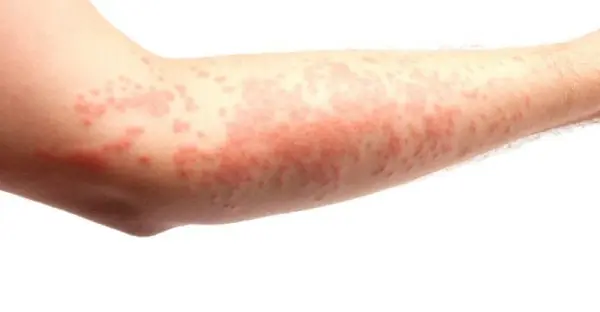
In most cases, angiomas do not cause any discomfort. Therefore, if the tumors itch, they may have a different origin. People with this disease usually attribute the appearance of small dots to allergies. And taking antihistamines rarely achieves the desired effect.
The solution for itching is not to treat yourself, but to consult a dermatologist who will make an appropriate diagnosis.
Only a doctor will determine the cause and prescribe the right drug or appropriate course of therapy.
Why do red dots appear in adults?
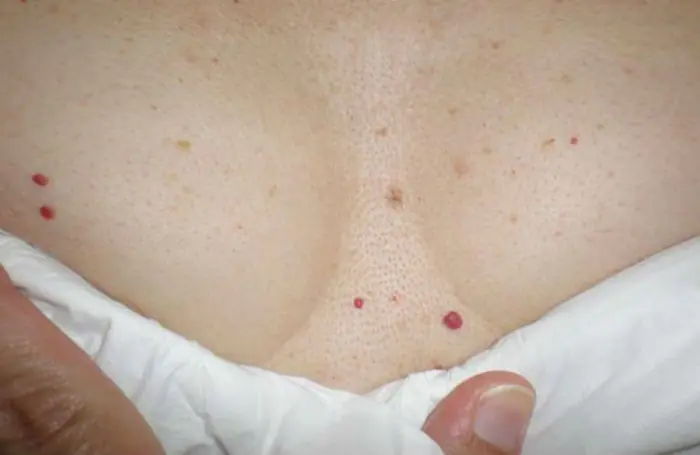
There are main factors that cause the occurrence of tumors in adults.
- Lack of essential vitamins in the body is a factor that causes spots to appear when the body of an adult lacks vitamin K or ascorbic acid. Deficiency leads to damage to the vascular walls. Taking a suitable vitamin complex helps to cope with the problem.
- problems with the pancreas and liver - causes of neoplasms such as impaired liver function, as well as pancreatic diseases, are eliminated with complex therapy. The main task is to treat the underlying problems, and the secondary task is to remove stains. Problems with the liver and pancreas are indicated by the appearance of red dots up to 2 mm in size in the upper torso and on the upper extremities. They do not appear below the waist. If such signs occur, consult a therapist. And the therapist will write out a referral to visit other specialists. The gastroenterologist will analyze the pancreas, the hepatologist will analyze the liver;
- accidental mechanical impacts - skin damage occurs as a result of shaving or hair removal procedures. Specks appear in the place where the hair was removed. In this case, the formations will have the nature of microtrauma;
- hemostatic disorders are blood clotting disorders, both congenital and acquired. In such cases, hemorrhages are observed inside and outside the skin, leading to the appearance of red dots. A hematologist will help you cope with the problem;
- Vascular diseases - Vascular diseases often lead to bleeding. Angiohemophilia and hemorrhagic diathesis are among the most common factors that result in red “moles”;
- diseases of the rheumatic type - lupus erythematosus, dermatomyositis, rheumatoid arthritis are accompanied by pain. The body's job is to provide anesthesia. For this purpose, it produces antibodies and a number of active substances, which are accompanied by skin formations throughout the body. The same thing happens with fungal infections, chickenpox, rubella, measles, meningitis, streptococcal infections;
- mechanical damage - an accidental blow or bruise can cause formations. Sometimes a push or a light blow is enough. Another option is to carry a heavy bag on your shoulder for a long time;
- Excessive exposure to ultraviolet radiation - if an adult often visits the beach or tanning salons, his skin will have excessive exposure to ultraviolet radiation. This often becomes a prerequisite for the appearance of red tumors.
Why do spots appear on the body during pregnancy?
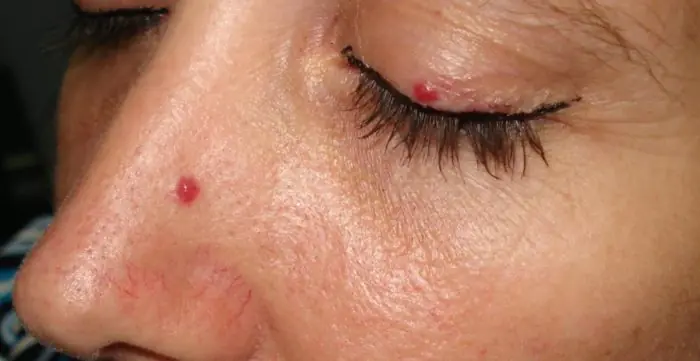
Pregnancy is always accompanied by hormonal imbalance, which becomes a catalyst for a number of processes. The female body has never encountered most of them before. The production of a significant amount of estrogen and progesterone is the main catalyst for the appearance of tumors.
Other reasons include:
- stretch marks on the skin;
- allergy;
- avitaminosis.
Skin sprains are a polymorphous dermatosis. Appears in the third trimester. The dots are small bumps that disappear after childbirth.
A severe lack of vitamins is accompanied by spots on the face or body. As for an allergic reaction, during pregnancy it is caused by different products.
Causes of appearance in children
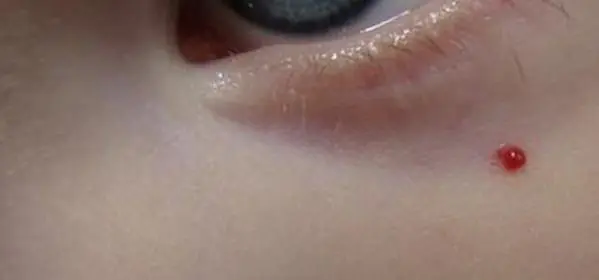
In a child, angiomas and other formations of a similar etymology are often the result of infectious diseases. If symptoms are observed in newborns, it means that the mother had an infection during the first trimester.
Other causes of neoplasms in children:
- microtraumas or small wounds;
- hormonal disbalance;
- avitaminosis;
- liver problems;
- problems with the pancreas;
- pigment disorders in the corresponding cells.
In any of the above cases, consult a doctor.
How is the treatment carried out?
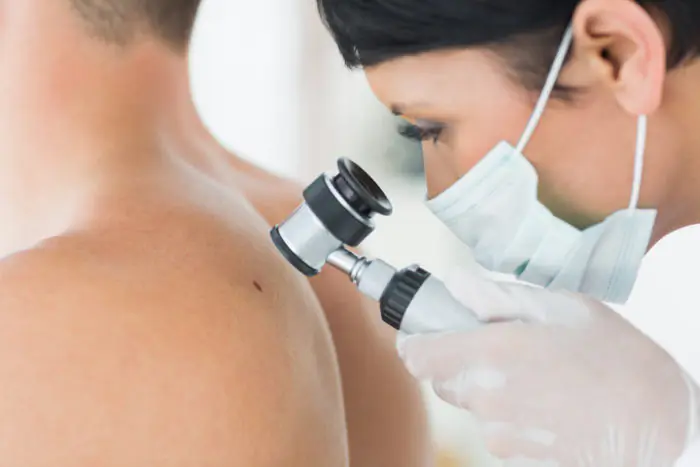
If dots in the form of red moles appear on the body of an adult or child, then, depending on their origin, one of several types of treatment is prescribed to get rid of the tumors.
The most common cosmetic therapy options are:
- cryodestruction;
- radiation therapy;
- surgical procedures;
- laser therapy.
Cryodestruction is the removal of spots with liquid nitrogen. After freezing, the formations disappear on their own. This is a virtually painless method.
Radiation therapy is used when the tumor is very stable. In these cases, the roots of the red “mole” are exposed to irradiation.
The surgeon's intervention involves cleaning out the bumpy spot with a scalpel. The procedure is performed under local anesthesia. A small amount of healthy tissue is also removed. Whereas a laser, used for the same purpose, acts on the skin without causing injury to healthy tissue.
Conclusion
Red dots that resemble moles - in most cases appear as a result of external factors. Such neoplasms do not pose a threat, and they can be removed using one of the convenient methods.
If the spots increase in size or are accompanied by itching, then problems with internal organs may be a factor in their appearance. Only an experienced doctor will make an accurate diagnosis.



